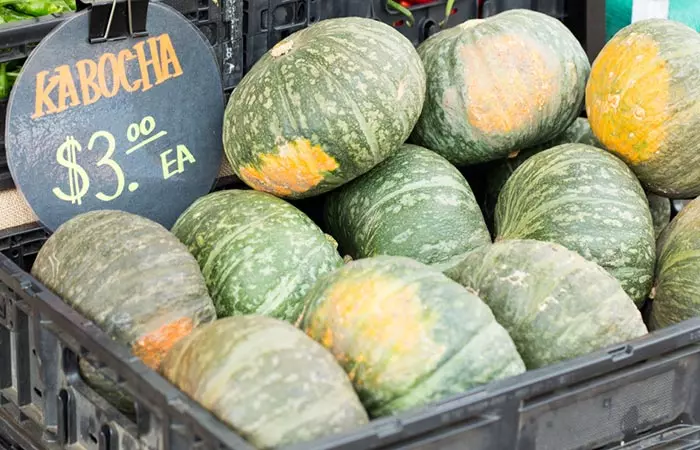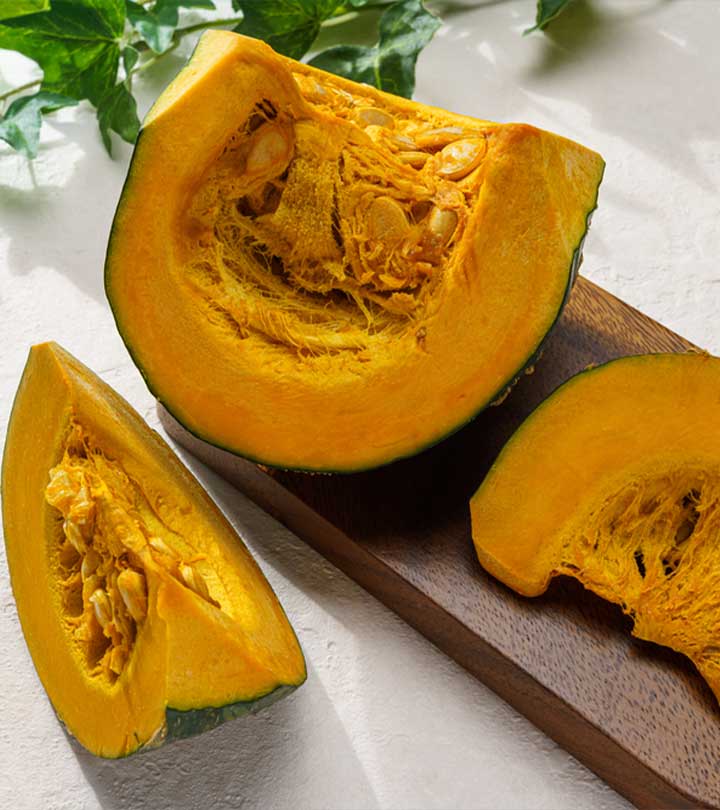Kabocha is a Japanese winter squash variety that is known for its rich texture and sweet taste. It is a smaller version of pumpkin and is related to the Cucurbitaceae family. The benefits of kabocha are many, and this winter squash is gaining popularity around the world due to its sweetness. It has a flavor similar to sweet potato, and you can find this squash in many cuisines, including Thai and Korean. This article explores kabocha’s nutrition facts, health benefits, and some easy recipes you can try at home. Keep reading to learn more.
In This Article
What Is Kabocha?
Known as kabocha in Japanese, danhobak in Korean, and fak thong in Thai cuisine, this versatile winter squash can be used in a variety of sweet and savory preparations.
You can roast, steam, or fry kabocha to make tempuras, as it tends to retain its shape well. It can also be mashed or pureed nicely with a finely grained texture.
The tough green outer skin is also edible once cooked and is rich in dietary fiber (1). Kabocha is widely used in Japanese cuisine mainly stewed, stir-fried, simmered in dashi or soups, deep-fried into tempura, or in desserts.
Varieties Of Kabocha Squash
Kabocha squash was introduced to Japan in the 16th century by Portuguese sailors. In Japan, “kabocha” refers to a wide variety of pumpkins and winter squashes. In western countries and elsewhere, “kabocha” refers specifically to only the Japanese member of the Cucurbita maxima family. Kabocha squash may come in varying colors, and are named as:
- Sweet Mama – green kabocha
- Winter Sweet – gray kabocha
- Sunshine – red kabocha
Trivia An average kabocha can weigh 2 to 3 pounds, while a large kabocha weighs up to 8 pounds.
Let’s now explore the nutrient content of kabocha squash.
Kabocha Squash Nutrition Facts
According to the USDA, 100g of kabocha squash can provide you with the following nutrients (1):
- Calories: 30
- Fat: 0g
- Protein: 1.1g
- Vitamin C: 9mg
- Sodium: 0mg
- Carbohydrates: 8.2g
- Fiber: 1.2g
- Sugars: 3.5g
Kabocha squash has a low-calorie count and is rich in vitamins A and C. It is also a good source of iron, magnesium, copper, B vitamins, dietary fiber, beta-carotene, and various other antioxidants.
Now, let’s explore the health benefits of these nutrients found in kabocha.
Kabocha Squash Health Benefits
Kabocha is low in calories and high in fiber and important vitamins. Let’s now understand how all this can help benefit our health.
- Lowers Cancer Risk
The cucurbitacins found in the winter squash and Cucurbitaceae family have also been found to be instrumental in preventing the development of certain cancers (2). Beta-carotene is a phytochemicali X Bioactive compound found in fruits and vegetables that act against bacteria, viruses, and fungi and offers desirable health benefits. found in kabocha squash. It gets converted to vitamin A in the body and might help prevent the risk of certain cancers (3). Moreover, vitamin C found in kabocha squash might also be helpful in preventing cancer (4). However, more human studies are warranted to validate these cancer-fighting claims.
- Supports Eye Health

Image: Shutterstock
The beta-carotene and vitamin C found, in kabocha have been shown to be effective in slowing down AMD (age-related macular degenerationi XAn eye disease that results in blurred or permanent central vision loss that worsens over time in older people. ) (1),(5). Additionally, people with a regular intake of vitamin C from food might have a lower risk of developing cataractsi XProtein build-up clouding the natural clear lens of the eye that helps focus light, leading to a decrease in vision that can affect one or both eyes. in their eyes (6).
Related: 25 Home Remedies To Improve Eyesight & Tips For Eye Care
- May Help Skin Care
Kabocha squash may also help clear your complexion by reducing scars and blemishes. The beta-carotene and various other antioxidants found in kabocha help reduce oxidative stressi XAn imbalance between the production of reactive oxygen species and the inability of a biological system to detoxify these compounds. and inflammation in the skin and prevent signs of aging (7), (8).
- Aids In Digestion
The dietary fiber in kabocha, especially in the outer edible rind, can provide multiple digestive benefits. When cooked and consumed, the outer rind can potentially help improve digestion, regularize bowel movements, and reduce bloating and other symptoms of constipation (9).
Related: 14 Home Remedies For Digestive Problems And Prevention Tips
Adverse Effects And Risks Of Kabocha Squash

Image: Shutterstock
Pumpkins, squashes, and other members of the Cucurbita family can produce certain toxic substances called cucurbitacins. These have a bitter taste and can cause severe diarrhea even when taken in small amounts (10).
An excessive intake of kabocha squash or any other fruit or vegetable containing beta carotene can develop a condition called carotenemia (11). This causes your skin to appear yellowish or orange in color. It is important to note that carotenemia is harmless and can resolve on its own once you cut back on the intake of carotene-rich foods.
Winter squash or kabocha allergies are very rare and not commonly heard of. In case you suspect an allergic reaction after consuming kabocha, you should consult your doctor.
Related: 10 Natural Remedies For Diarrhea + Causes, Symptoms, And Prevention Tips
Storage And Food Safety

Image: Shutterstock
Kabocha squash, being winter squash, is usually grown in the warm season and is available from October to January.
- When buying a kabocha, it is better to buy it from your local farmer’s market to avail it freshly harvested.
- Choose an average-sized kabocha with hard, thick skins and dry and intact stems.
- You should avoid any kabocha with soft or rotten stems, soft blemished spots, cuts, or damaged in other ways.
- Whole kabocha can be stored for 2-4 months at home in a cool and dry place.
- Cut portions of kabocha should be used as soon as possible. They can otherwise be wrapped in plastic film or kept in a ziplock bag stored in the fridge for 1-2 days maximum before use.
- You can also keep cooked squash in the freezer, where it will last for up to a year.
Recipes, Preparation, And Serving Methods
Once you get a kabocha from the farmer’s market or your nearest supermarket, you need to wash and clean it nicely. Kabocha is known for its thick and sturdy outer skin that is tough to cut through. You might need a big vegetable knife and some arm pressure to cut it in half. You can further cut it into moon-shaped slices or cubes as per your recipe requirements. Below, we have shared a few popular recipes to spice up things for you.
Kabocha Recipes
1. Kabocha Shiratama Dango
Image: Shutterstock
Ingredients
- Shiratama (glutinous rice flour) – 3 tablespoons
- Kabocha (steamed, peeled, mashed) – 1 tablespoon
- Maple syrup – ½ teaspoon
- Water – to bind
Instructions
- Take the mashed pumpkin paste, shiratama rice flour, and maple syrup in a bowl and combine well with just enough water to bind.
- Blend everything to form a dough about the size of a tennis ball.
- Break off small pieces and roll them into small balls with your hands.
- Bring a pot of water to boil and drop in the balls.
- They will float to the top once done.
- Leave them in there for one extra minute.
- Scoop the balls out and drop them into ice-cold water.
- Pat each of them dry and string in along the skewers.
- Top it with a sauce or sprinkle of your choice and enjoy.
You should have enough to make three skewers, each one having three dango.
2. Roasted Kabocha
Image: Shutterstock
Ingredients
- Kabocha squash (medium ) – 1 (2 ½ lb.)
- Extra-virgin olive oil – 1½ tablespoons.
- Kosher salt
- Black pepper (freshly ground) – as per taste
- Butter – 3 tablespoons
- Soy sauce (low-sodium ) – 1 tablespoon
- Maple syrup – 1½ teaspoons
Instructions
- Preheat the oven to 400℉ and line a baking sheet with aluminum foil.
- Cut the squash in half and scoop out the pulp and seeds.
- Cut the half squash further into 1 ½” half-moon-shaped slices.
- Drizzle a little oil over them and season with salt and pepper.
- Toss the pieces nicely to coat evenly and line the slices in the baking sheet.
- Roast the squash slices for about 30 to 35 minutes, flipping sides halfway through, until they are tender and begin to brown.
- Meanwhile, melt butter in a small saucepan over medium-low heat.
- Cook until the foam subsides.
- Continue to cook for 2-3 minutes, stirring constantly until the butter smells like caramel.
- Remove the butter from heat immediately and add in the maple syrup and soy sauce.
- Stir until thoroughly combined and cooled slightly.
- Return the sauce over medium heat and bring to a simmer.
- Cook for 1 to 2 minutes more until it gets slightly thickened.
- Transfer the roasted squash pieces to a platter.
- Drizzle with the maple soy brown butter, serve and enjoy!
Did You Know? Koreans use kabocha to make ‘hobak-juk,’ meaning pumpkin porridge, while Jamaicans add kabocha to chicken foot soup as a one-pot dish.
Along with the above, you can use kabocha in any recipe that calls for butternut, sweet pumpkin, or acorn. Below are a few more ways to include them in your diet and serve them differently.
- Kabocha can be used in sushi, soups, and tempura dishes.
- Raw kabocha can be grated and used in winter salads to add that bright orange tinge and sweet flavor.
- You can also cut and deseed the kabocha and stuff it with grains, bread, bacon, meat, mushrooms, cheese, or your favorite leafy greens, and bake in the oven.
- You can make kabocha squash gratin and enjoy it with sausage or vegetables.
- Mashed/pureed kabocha can be used as a healthy alternative to mashed potatoes.
- Baked and mashed/pureed kabocha flesh can be used as a filling for ravioli, empanadas, and enchiladas, or used in pies, puddings, bread, and desserts.
- Kabocha squash can be made into a delicious creamy soup as well.
- Roasted kabocha squash kernels can be eaten as a healthy snack anytime.
Kabocha, or Japanese pumpkin, is a type of winter squash. It is a great source of beta-carotene, vitamin C, fiber, and antioxidants. These nutrients in kabocha benefit your health in many ways. The intake of this low-calorie squash may lower the risk of cancer, support eye health, promote skin health, and aid in digestion. However, excess intake of this squash variety may cause carotenemia (skin discoloration due to excess beta carotene). You can prepare many delicious recipes with kabocha. Hence, consume it in moderation to enjoy its maximum health benefits.
Frequently Asked Questions
Is kabocha a Superfood?
Yes, with its rich vitamin and nutrient content and the antioxidant properties of beta carotene, kabocha is considered a superfood by many (1).
Is kabocha okay for keto?
Kabocha squash is not okay on a ketogenic diet because of its high carb content. A 100g serving provides you with 8 grams of carbs (1). This can also easily add up depending on the other components of a dish. So, it’s best to avoid kabocha squash and opt for keto-friendly alternatives like the summer squash or scallop squash.
Subscribe
Is kabocha squash a starchy vegetable?
With its carbohydrate and fiber content, kabocha is a low-calorie starchy vegetable.
Can you eat squash every day?
Yes, squash is low in calories and rich in nutrients, and can be a healthy addition to your diet every day.
Can squash give you gas?
Due to its rich fiber content, excessive squash intake may lead to flatulence and stomach discomfort.
Is squash good for kidney disease?
Squash intake is acceptable in the early stages of chronic kidney disease, as long as there are no such dietary restrictions.
Key Takeaways
- Kabocha is a Japanese sweet winter squash with a sweet, nutty flavor.
- You can cook, stew, stir-fry, or simmer its orange pulp and fiber-rich skin and use it for several culinary preparations.
- Kabocha is rich in vitamins A, B, and C, minerals, dietary fiber, beta-carotene, and other antioxidants.
- It helps improve eye, skin, and gut health and offers other important benefits.
Sources
Articles on StyleCraze are backed by verified information from peer-reviewed and academic research papers, reputed organizations, research institutions, and medical associations to ensure accuracy and relevance. Read our editorial policy to learn more.
- KABOCHA SQUASH
https://fdc.nal.usda.gov/fdc-app.html#/food-details/1963721/nutrients - Cucurbitacins – A Promising Target for Cancer Therapy
https://www.ncbi.nlm.nih.gov/pmc/articles/PMC3612419/ - Effectiveness of beta-carotene in cancer chemoprevention
https://pubmed.ncbi.nlm.nih.gov/7647689/ - Vitamin C and cancer prevention: the epidemiologic evidence
https://pubmed.ncbi.nlm.nih.gov/1985398/ - Vitamin C
https://ods.od.nih.gov/factsheets/VitaminC-Consumer/ - A Randomized Placebo-Controlled Clinical Trial of High-Dose Supplementation With Vitamins C and E Beta Carotene and Zinc for Age-Related Macular Degeneration and Vision Loss
https://www.ncbi.nlm.nih.gov/pmc/articles/PMC1462955/ - β-carotene in skin care
https://www.researchgate.net/publication/347513828_b-carotene_in_skin_care - Comparison of Nutritional Composition and Antioxidative Activity for Kabocha Squash and Pumpkin
https://www.researchgate.net/publication/264131737_Comparison_of_Nutritional_Composition_and_Antioxidative_Activity_for_Kabocha_Squash_and_Pumpkin - Constipation dietary fiber and the control of large bowel function
https://www.ncbi.nlm.nih.gov/labs/pmc/articles/PMC2418066/pdf/postmedj00129-0102.pdf - Gourds and squashes (Cucurbita spp.) adapted to megafaunal extinction and ecological anachronism through domestication
https://www.pnas.org/content/112/49/15107 - A review
https://pubmed.ncbi.nlm.nih.gov/7449242/
Was this article helpful?
“>
Related
The following two tabs change content below.
- Reviewer
- Author

Janelle Bigelman, MS, RDN


Janelle Bigelman is a registered dietitian with 3 years of experience. Being an athlete and heavily invested in sports while growing up, she quickly learned the interconnection of optimal nutrition and how one’s daily dietary habits can impact one’s overall health, longevity recovery and performance, both positively and negatively. This led her to open her own private nutrition consulting business…View Profile ›

Varsha Patnaik, Health & Wellness Writer

Varsha holds a master’s degree in biotechnology from Ravenshaw University, Cuttack, and is a certified diet and nutrition coach with two years of experience. She combines her scientific knowledge and her passion for writing to produce research-backed content in the health and wellness domain. Her writing focuses on the health and nutritional benefits of various ingredients and diets and how…View Profile ›
